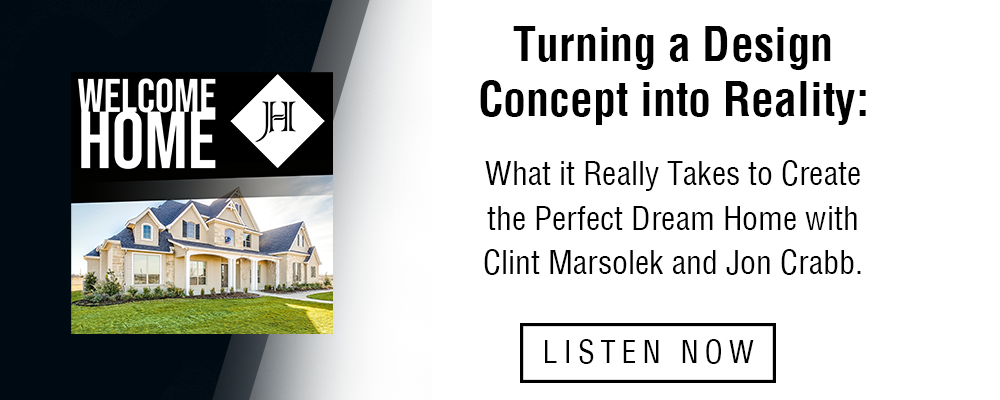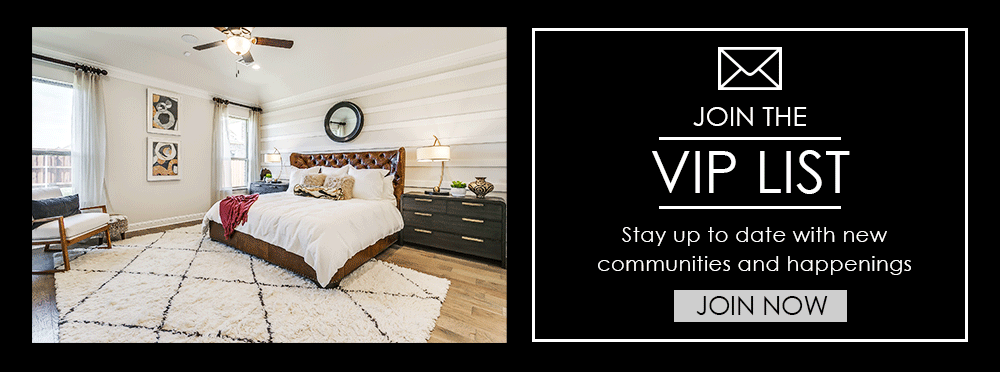Ep. 16_Keystone Architecture with Clint Marsolek & Jonathan Crabb
A crucial step in the home building process is working with the architects to turn your concept into a reality. Today you'll hear from the President of Keystone Architecture, Clint Marsolek, and Custom Project Manager, Jon Crabb, as they walk us through what it really takes to create the perfect dream home for their customers.
Ep16_Keystone Architecture (Clint Marsolek & Jonathan Crabb)
Intro: [00:00:03] Welcome Home, a podcast brought to you by John Houston Custom Homes. Join hosts, Chelsi Frazier and Whitney Pryor, as they walk you through the exciting adventure of your home buying and building journey.
Natalie Crabb: [00:00:18] Hey everyone! Thanks for joining us on this episode of the Welcome Home Podcast. This is our 2nd take over and we are so excited to be here! I'm Natalie Crabb and I'm joined by my fabulous co-host, Hannah Lippert. Hannah, how are you doing today?
Hannah Lippert: [00:00:31] Hey Natalie, I'm great! I'm Hannah Lippert and I'm also part of the marketing team here at John Houston Custom Homes. I'm really grateful to be a part of such an amazing Marketing Team and to be a part of this podcast today. I'm super excited.
Natalie Crabb: [00:00:43] Yes, I totally agree. We have the privilege of hearing from two guests that we haven't had on the show yet. I'm super excited to hear from these two because they really know their stuff. We have with us Clint Marsolek, who's the President of Keystone Architecture. We also have my amazing husband, Jonathan Crabb, who is the Custom Project Manager for Keystone Architecture. Welcome Clint and Jon! Thanks for joining us today.
Jonathan Crabb: [00:01:06] Hello.
Clint Marsolek: [00:01:07] Hello.
Natalie Crabb: [00:01:08] Clint, tell us about how long you've been with the company.
Clint Marsolek: [00:01:10] I have been with the company for 7 years.
Hannah Lippert: [00:01:13] How did you get started in architectural design? Where did that come from for you?
Clint Marsolek: [00:01:17] I first started at church. I was with my family. I was offered a position building cabinets with one of the guys that went to our church. That just kind of started the housing industry, ins and outs, of how does this go together and that kind of thing. The next job that I had was framing houses, then trimming houses, so it just continued to roll into this understanding of the way that houses actually go together. I ended up going to school and the career path took me into Construction Science. I was like, I think this is something that I can do.
Hannah Lippert: [00:02:06] Right, I'm sure having that background of actually being in it, doing the work with your hands yourself, made the learning process and school so much easier.
Clint Marsolek: [00:02:18] Yeah, it was just so familiar. Even some of my professors, I felt like I was teaching them things and in some cases I.
Natalie Crabb: [00:02:26] Well, it doesn't surprise me, that's awesome. Jon, tell us a little bit about you, your background and how long you have been with John Houston Custom Homes?
Jonathan Crabb: [00:02:36] I've been the company for 6 years. Growing up, I've always wanted to get in the house design. After High School, I went to Architecture School. I have my Bachelor's in Architecture. Shortly after school, I started working for a restaurant that needed a remodel. They thought about opening up new stores, so I did the designs, city requirements, etc. After they didn't have any more work, I decided to branch out and annoy Clint with my resume and emails.
Clint Marsolek: [00:03:12] Good job.
Hannah Lippert: [00:03:14] I'm guessing you're successful.
Jonathan Crabb: [00:03:16] I'm here.
Hannah Lippert: [00:03:17] I love it.
Natalie Crabb: [00:03:17] I remember the sleepless nights that Jon had at UTA. He would say, "Hey, I'll see you in a week." He would take a piece of plywood and a sleeping bag and camp out underneath the drafting table in his Architecture Class. It would be weeks and weeks and bring him snacks from across the bridge. I know how hard he has worked, so I'm super excited that you're here, and you're doing so well. First, let's talk about the steps of the design process and how it's organized. Clint, let's start with you. What are your thoughts?
Clint Marsolek: [00:03:49] In the design process, whenever we're working with clients, we'll work on a concept for the buyer. Then, working through that process with them - what is it that they need in the house? How is it that they live? Once we nail down the concept, then we finish out the construction drawings for the permitting process through the city. They'll get a price to the buyer and then at that point, we'll start to actually build the house. It's a relatively quick process, depending upon the client's needs. Sometimes it takes us a little bit to draw what is in their head.
Hannah Lippert: [00:04:36] What is the process that you use to get to know your client and their needs when you're designing their home? How do you guys how do you guys go about that?
Clint Marsolek: [00:04:45] My process is and I think Jon's is pretty close to the same, but my process is just really just listening well, number one. The client's trying to figure out how to explain what their needs are. Walking them through a design of a home, what the requirements are and then working in what their needs are, is the task. I think listening well and putting that guidance together to where we're guiding them through what the design looks like, is important. It's listening to the client, what their needs are and initiating that in design. It's a simple task, but, there are parameters depending upon what they're planning on doing with the house.
Jonathan Crabb: [00:05:43] A lot of the time, the clients don't know what questions to ask. We'll get in there and ask them, what's the purpose of the house? Is it going to be rent or buy? Are you going to be in it for years or decades, what's the idea? Are you going to grow a family in it? We ask questions like that. Sometimes home building, designing, etc., can be daunting. There's a lot of questions that they don't ask themselves and that's what we try to ask them.
Clint Marsolek: [00:06:17] We're drawing it out of them. What is your plan? We ask a lot of questions.
Natalie Crabb: [00:06:26] That's great though because it is such a huge investment. You definitely need to know exactly what your client needs.
Clint Marsolek: [00:06:31] We want to make sure that we do a thorough job in it. We take each one personally.
Hannah Lippert: [00:06:36] That probably helps you guys in the long run and the client. That way, you're not halfway through the build process and they realize, oh, I forgot this one thing. Whereas, it could have been avoided if maybe more questions were asked on the front end.
Natalie Crabb: [00:06:49] How do you help your clients narrow down their specific needs when designing their new home?
Clint Marsolek: [00:06:55] When narrowing down specific needs for the buyer, again, it goes back to listening. With listening well, we're actually asking them specific questions that have to do with, are you going to be entertaining? Do you have family stay with you often? How many kids do you have? It's like Jon said earlier, is this your forever home, because if it's not, maybe things that they need to think about is appealing to a large demographic, instead of personalizing their home. It's just asking a lot of questions, a lot of personal questions about. Do they have dogs? Some people find their animals to be a big part of their life. They design their houses around, in some cases, their animals, which is something we deal with on occasion.
Natalie Crabb: [00:07:53] Do you have an example of anything like that?
Clint Marsolek: [00:07:57] Yeah, actually, I have designed a separate home off of the buyer's home for a couple of dogs. They essentially had their own dwelling.
Natalie Crabb: [00:08:14] That's what's great is you guys are so detailed in your custom design. You're say, okay, let's take what the client wants, work with it, look it back over, give suggestions, and you get on that personal level, which is really great. It's great to see the work that you guys do.
Hannah Lippert: [00:08:34] I have a question. Do clients often ask you guys, the designers, what style of home they should choose? You probably at this point, are good at really narrowing down what the client wants, steering them in the right direction, but do you guys ever have clients who come to you that just absolutely have no idea what they want and you guys are kind of guiding them the whole way?
Jonathan Crabb: [00:08:55] Oh, yeah, definitely. In our files, we like to keep a catalog of different styles. We'll show them different pictures. Floor plan designs are based on different styles. Along with the questions we ask, we'll put together a scenario of do you want a Farmhouse or even bring it up today styles. Today styles a big thing like Clint said earlier. For resale purposes, you are going to find a niche house in, let's say, Waxahachie that won't resell if that's their intention.
Clint Marsolek: [00:09:25] They do ask us that question a lot and we try to steer them in the right direction. A lot of times we can suggest certain styles, but then that may not be what they're actually picturing in their mind, even though that they say that they don't really have an idea. Truly, they usually have an idea. A lot of times what we do is we ask the buyers to get some pictures together, so we can work through the pictures so that we can direct them as to what does catch their eye. What catches their eyes is really what they're looking for in a style of home. Then we direct them towards that style because that's what really makes them happy. A lot of times in the design, Jon and I will , work with them, work that style up and then give them a concept based off of what it is that does catch their eye. Usually, that's the style that they want, even though unknowingly they don't know that's what they are desiring.
Hannah Lippert: [00:10:27] They just can't put it into words.
Clint Marsolek: [00:10:28] Yes, they don't know the names of what the styles are, so that's usually how we direct them, wouldn't you say, Jon?
Jonathan Crabb: [00:10:35] Oh, yeah, especially nowadays, there's so many styles that overlap.
Clint Marsolek: [00:10:40] Sometimes we'll even ask them for their Pinterest.
Natalie Crabb: [00:10:42] I love it!
Natalie Crabb: [00:10:44] You can't go wrong with Pinterest.
Hannah Lippert: [00:10:45] It's changed the game in home Building.
Clint Marsolek: [00:10:47] It has helped in the past.
Natalie Crabb: [00:10:50] Well, that kind of takes us on to our next question about what are the current trends that you guys are seeing in homes right now with exterior interior?
Jonathan Crabb: [00:11:00] Farmhouses, modern Farmhouses are a big thing, even painted brick is coming back. That's a popular item. French Country Cottage, steep gable's, it makes the house look more grand in that style.
Clint Marsolek: [00:11:15] Yeah, it definitely makes the streetscape of the neighborhood look gorgeous, a lot of different architecture going on.
Hannah Lippert: [00:11:23] What about trends and floor plans- one story, two story? Do they want the extra bathroom? What are you guys seeing when it comes to what buyers are wanting with their floor plan?
Clint Marsolek: [00:11:34] What we're seeing here lately is a large suite bath - an oversized bathroom, large walk-in showers and split vanity's. We're seeing split closets a lot and oversized islands for entertaining. Recently, we've incorporated the dining room, kitchen and family room all in in one row, which is becoming a very popular design.
Hannah Lippert: [00:12:11] Just one big open, concept?
Clint Marsolek: [00:12:15] Yes. A lot of times will vault the ceiling in the space, which you can add cedar details on the ceiling or a different type of coffer. It's a great look. If entertaining is your thing, that definitely opens the space up for that to happen.
Natalie Crabb: [00:12:35] I love that. What are you seeing, Jon?
Jonathan Crabb: [00:12:38] Here lately, I would say single stories are common, especially with new homebuyers with newborns. While their kids are growing, they don't want the stairs for the kids to climb.
Hannah Lippert: [00:12:51] Or maybe even empty nesters who have sent their kids off, I'm sure they've done their dues of climbing those stairs. They're over it.
Clint Marsolek: [00:12:58] I'm over it.
Natalie Crabb: [00:12:59] I'm sure, like Clint said, with the split vanity's and split closets, I'm sure that'll be on the list for our next home, right, Jon?
Jonathan Crabb: [00:13:08] Oh, definitely. I have one shelf. She has the dresser and closet.
Natalie Crabb: [00:13:14] Listen, that's part of it.
Hannah Lippert: [00:13:16] Happy wife, Happy life.
Natalie Crabb: [00:13:18] With that, what's one of the most popular floor plans that you guys are seeing, that's lot of attention these days?
Jonathan Crabb: [00:13:27] A month ago, I would say the Athens floor plan. We have a plan called the Madrid that has the same layout that Clint was talking about, with the kitchen, the dining and family, all in one area. What's good about the Madrid, is where the kitchen sink is. It is actually facing an outside window towards the backyard. A Lot of people are liking that design, so the Madrid is becoming a little more popular.
Clint Marsolek: [00:13:53] There's another design that we have that has a garden feel with the sink facing the backyard. It is a great look. It achieves, that garden feel with light coming in to the kitchen, that lights up the room. It is a great look and warms up the entire space.
Natalie Crabb: [00:14:17] I was going to ask if that natural light, more windows is being requested? I would love to have the kitchen sink facing a window.
Clint Marsolek: [00:14:25] That is something that we incorporate in a lot of our designs, even if we have to kind of go out of our way to get light to come into the space of the kitchen, we do it. We were very intentional about that.
Natalie Crabb: [00:14:39] I love that.
Hannah Lippert: [00:14:40] With people staying home more, during the pandemic, have you guys noticed how that's affected the building process? Are people requesting things to cater to that- to parents being home more, to kids being home, or have you noticed how that has affected any of your designing?
Jonathan Crabb: [00:14:59] Oh, definitely. Similar to what Clint was saying earlier, the guest suite, the second master suite is becoming real popular. The mother-in-law houses, detached and separate, is being ordered as well quite a bit.
Clint Marsolek: [00:15:17] We're getting more requests for office spaces and reconfiguring some of the houses to meet the needs of the buyer, because a lot of people are staying at home. Those are design requests that we're getting.
Jonathan Crabb: [00:15:37] Client's are bringing in their their parents, the elderly. We're seeing a lot of ADA requests now- larger showers and floating pads, so they don't trip easily.
Natalie Crabb: [00:15:49] With our floor plans, what's one of the most requested add on options that you guys have seen? What is the most popular?
Clint Marsolek: [00:15:57] I would say the the bath, the deluxe suite baths.
Jonathan Crabb: [00:16:02] I would say larger shower and third car garage.
Clint Marsolek: [00:16:07] Yeah, that's one that we do all the time.
Jonathan Crabb: [00:16:11] We looked at numbers here recently. I think near 80 % of our clients are upsizing their windows to bring in more light. That's a very common request nowadays.
Clint Marsolek: [00:16:24] On our designs, we have large windows. That's something that we're really intentional about is having larger windows in the designs, but they're even making the windows even larger.
Hannah Lippert: [00:16:38] Wow. What about energy efficiency? Have you noticed that becoming a really important request for energy efficient windows, insulation, all of that?
Clint Marsolek: [00:16:47] That's something that we do as a standard on the designs. Everyone has an energy design behind it, but a lot of buyers will do foam insulation, which at that point it's very sealed. It's very energy efficient. It actually doesn't take very much energy for the home to function.
Natalie Crabb: [00:17:15] What would you both say sets our plans apart from other homebuilders? What sets John Houston Custom Homes floor plans apart?
Clint Marsolek: [00:17:26] I think that the care that we put into the design itself. Functionality, is something that we make sure we execute, functionality behind what the buyer's needs are. There's a couple of different buyers that we focus on. One is, just like you mentioned earlier, empty nesters. Two, is your first time buyer. Three, is your second and move up buyers. We focus on on all of their needs inside of our designs. We'll do functional gathering for the spaces, as well as, empty nesters where it's the size of the house that really matters, the square footage, price sensitive. The same thing with first time buyers, price sensitive is where that that the focus is. On our second time and move up buyers, at that point it's gathering, it's social. It's more space. It's getting a lot of light into the house and expand the design criteria to meet what their needs are. Is it, you know, larger baths? Is it 3rd-car garages? There are just a lot of different ideals behind the designs.
Jonathan Crabb: [00:18:50] Even listening to our sales team, helps out quite a bit as well. They're actually on the front line finding what the trends are, what clients are needing. That's why we've been changing or updating our plans, I would say, for the larger windows, the second master suites and ADA requirements.
Clint Marsolek: [00:19:10] Keeping up with trends is a big thing that we do.
Natalie Crabb: [00:19:14] I know we kind of hit on this topic a little bit earlier about some customer requests that you guys have received. Are there any other wild custom, requests that you've had ,maybe recently or in the past, that you want to share with us?
Clint Marsolek: [00:19:31] We did a house that was almost 20,000 square feet.
Natalie Crabb: [00:19:36] Wow!
Clint Marsolek: [00:19:36] It was huge.
Hannah Lippert: [00:19:36] How many rooms?
Clint Marsolek: [00:19:38] I want to say it was 6 rooms. The rooms are really oversized.
Natalie Crabb: [00:19:42] That's amazing.
Clint Marsolek: [00:19:43] The largest part was, which was really interesting was, it must have had almost 4,500 square feet of outdoor entertainment. I think that the back porch was like 50'x 50' or something. It was just enormous!
Hannah Lippert: [00:20:03] I want to go to their house party!
Natalie Crabb: [00:20:05] Seriously!
Clint Marsolek: [00:20:06] Yeah, you know hey were entertaining. It wrapped around the entire back of the house. We were like, "oh, my gosh, that would be so much fun to have!" You can picture yourself entertaining so many different people.
Hannah Lippert: [00:20:24] Well, let's wrap it up with one more question. What do you guys love most about designing a home? What's your favorite part? Clint, we'll start with you.
Clint Marsolek: [00:20:31] My favorite part is the gratification that we get from working with the client. The appreciation that they show for the experience that they get when spending time to design their personal home. It is just hugely gratifying to see their face light up, smile and just be so happy about the experience. I think that's the reason why I still do this today. It makes me feel like I'm accomplishing what my life was meant to be every time they get excited to work with us.
Natalie Crabb: [00:21:13] I love that.
Clint Marsolek: [00:21:15] It's a great feeling.
Natalie Crabb: [00:21:17] Jon, what about you?
Jonathan Crabb: [00:21:18] I would say the memories that are being made. Is that their first home? Is it the home that their kid is going to remember. Will they remember that this is where I grew up first or even second or third? That's what I think always sticks with you. It's the possible memories that are being made and the memories that are made.
Natalie Crabb: [00:21:42] Definitely, that personal connection that you guys get, day one sitting down with them all the way up until it's built, I bet that's an awesome journey to be on with them from the ground up.
Clint Marsolek: [00:21:54] It is.
Natalie Crabb: [00:21:55] That's awesome! Well, thank you guys so much for joining us today on our second podcast Take-Over. We really appreciate it and really appreciate all of the wonderful information. Thank you Clint and Jon.
Jonathan Crabb: [00:22:08] Thank you.
Clint Marsolek: [00:22:09] Thanks for having us.
Natalie Crabb: [00:22:09] Thank you listeners for joining us on this podcast Take-Over. We hope you've enjoyed it! Be sure to click the description for episode notes and links to more information about our building process. For information about John Houston Custom Homes, check out our website at www.johnhoustoncustomhomes.com. Follow us on Facebook, Instagram, Twitter or even LinkedIn. For any other questions or comments, call us at 866.646.6008 or email us at info@jhoustonhomes.com
Hannah Lippert and Natalie Crabb: [00:22:40] And as always, Welcome Home!






